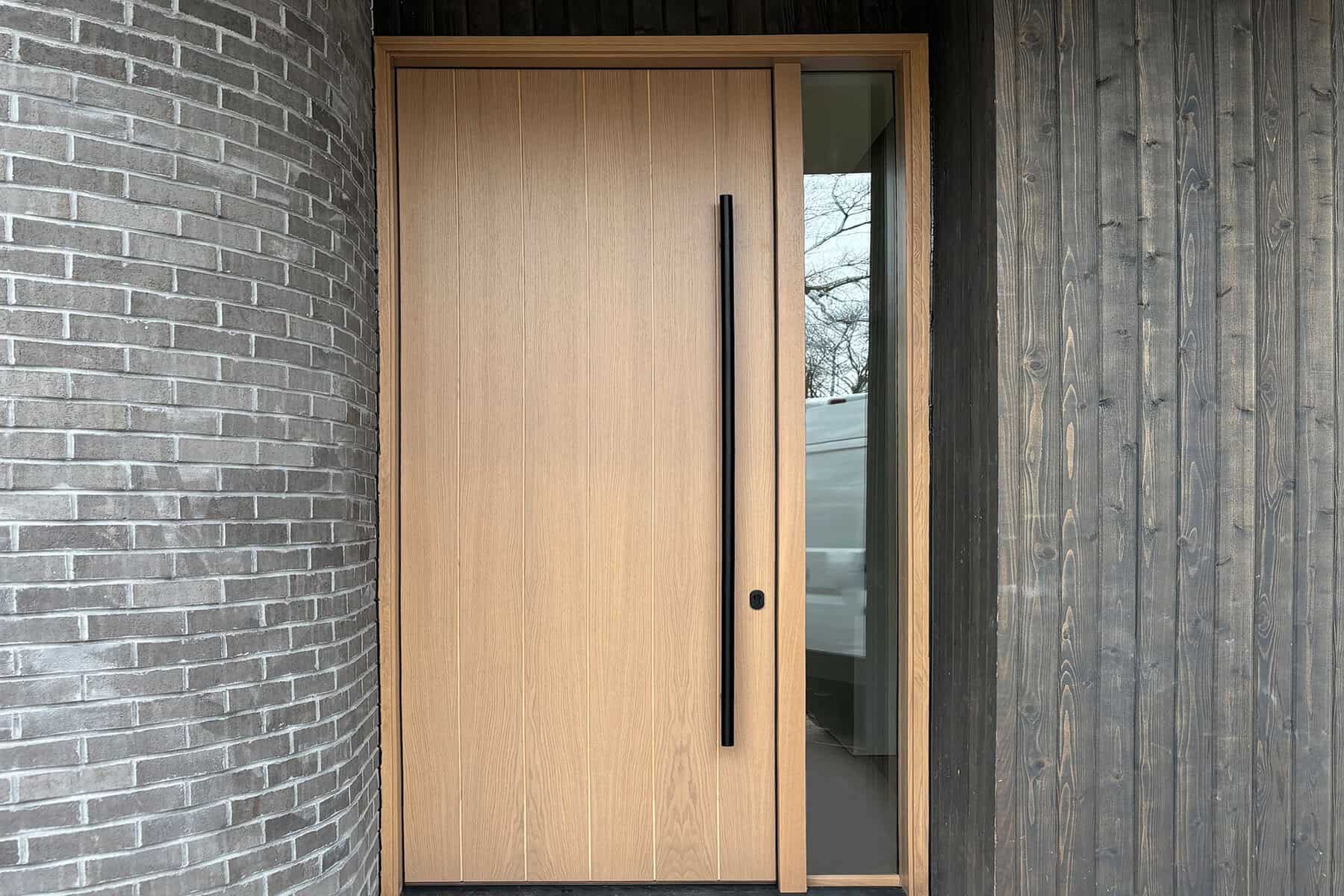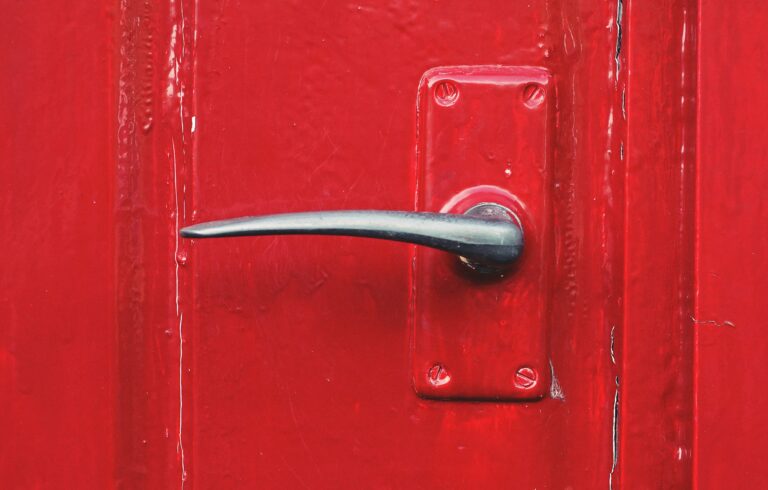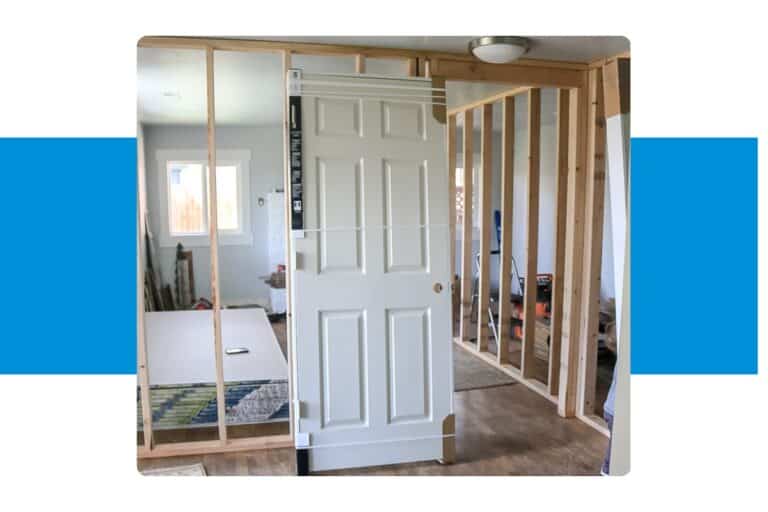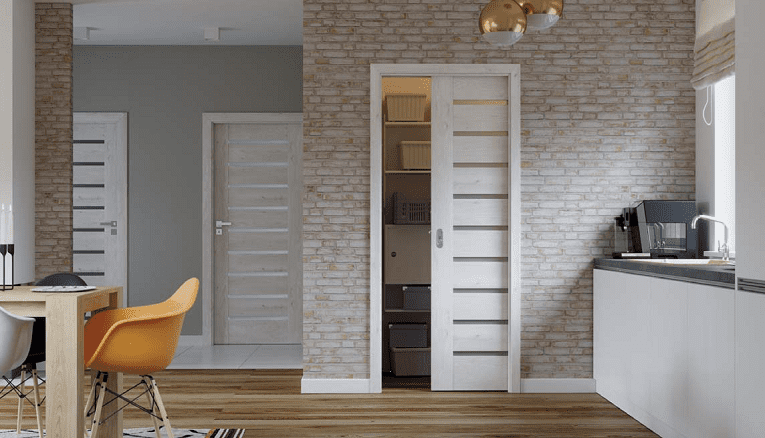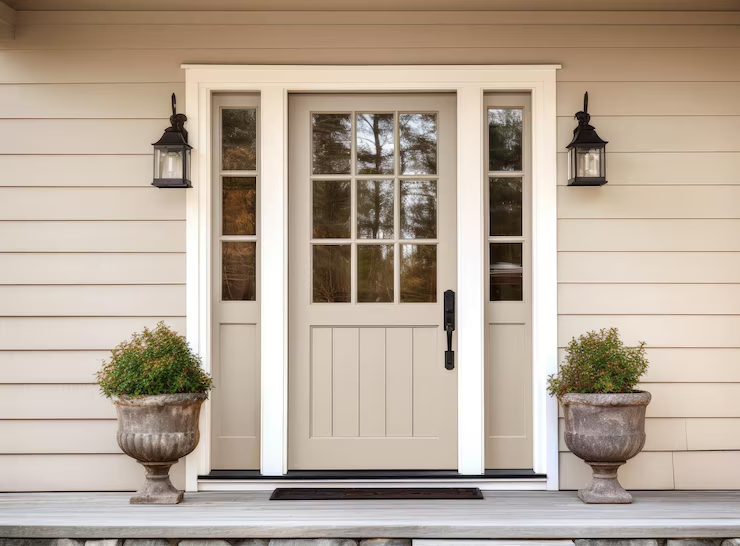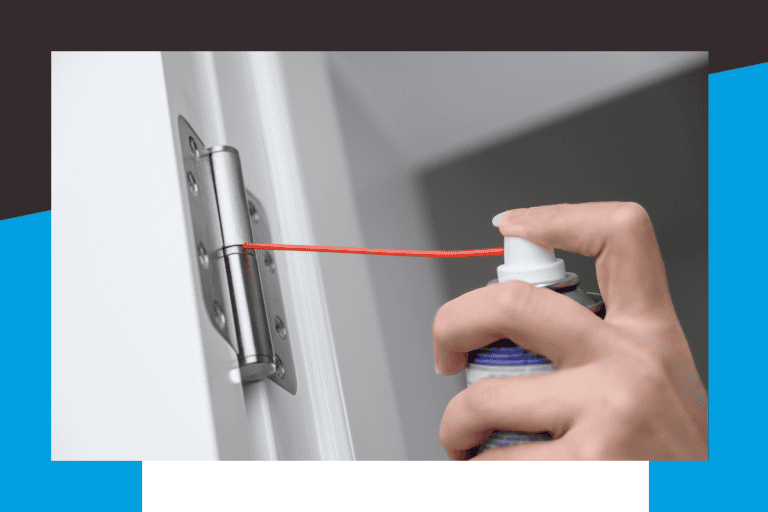Choosing Exterior Doors
When it comes to home improvement, selecting choosing exterior doors is one of the most important decisions you can make. These doors are not only functional—protecting your home from intruders and the elements—but they also serve as a focal point of your home’s exterior design. They play a key role in enhancing your home’s curb appeal, ensuring energy efficiency, and providing safety.
With so many options available in terms of style, material, size, and security features, choosing the perfect exterior door can seem overwhelming. However, by carefully evaluating your needs and understanding the available choices, you can find a door that enhances both the aesthetics and functionality of your home. This guide will help you navigate the key factors involved in choosing the best exterior doors, focusing on style, material, durability, fit, security, and energy efficiency. Let’s dive deeper into each of these aspects.
1. The Importance of Choosing Exterior Doors
Before we dive into the details, it’s important to understand why choosing exterior doors matters so much. Choosing exterior doors serves several critical functions:
- Security: A strong, well-constructed door helps to protect your home from potential intruders. Investing in high-quality materials and locking systems can increase your home’s safety.
- Energy Efficiency: Exterior doors can prevent drafts and air leaks, ensuring your home stays warm in the winter and cool in the summer. Proper insulation can save you significant energy costs.
- Curb Appeal: Your front door is often the first thing visitors notice about your home. A well-chosen door can dramatically enhance the appearance and value of your property.
- Durability: Exterior doors are exposed to harsh weather conditions, from rain and snow to extreme sunlight. The material and build of your door need to withstand these challenges while maintaining functionality and aesthetics.
By considering these factors, you can make an informed decision when selecting an exterior door for your home.
2. Understanding Door Styles and Design
The style and design of your door can greatly influence the overall look and feel of your home. It’s important to choose a door that complements the architectural style of your house while reflecting your personal taste. Here are some popular styles to consider:
Traditional Doors
Traditional doors are often found in homes with classic or historical designs, such as Colonial, Victorian, or Craftsman-style homes. These doors typically feature intricate details, raised panels, and decorative glass inserts. Traditional doors can be made from wood or fiberglass, and they often have a rich, warm appearance that complements more ornate architectural designs.
For instance, if you own a Victorian-style home, consider a door with elaborate moldings, frosted glass panes, or even stained glass. These details add charm and elegance to your entrance. On the other hand, for Craftsman homes, a wooden door with a windowpane at the top and natural wood grain would be more suitable.
Modern and Contemporary Doors
Modern and contemporary homes require doors with clean lines and minimalistic features. These doors are often made from materials like steel or glass and come in bold colors or sleek, neutral tones. Unlike traditional doors, which are rich in detail, modern doors focus on simplicity and geometric shapes.
A door for a modern home might have a flat surface with a matte finish, perhaps featuring narrow vertical or horizontal windows for an added touch of design. For contemporary homes, glass doors with aluminum or steel frames provide a sophisticated and sleek entrance that enhances the streamlined design of the home.
Rustic and Farmhouse Doors
Rustic and farmhouse doors are ideal for homes with country or rural architecture. These doors often have a more rugged look, with distressed wood, large iron hardware, and a barn-door style. They work well in homes with exposed beams, stone walls, or a natural, earthy aesthetic.
For a farmhouse-style home, a door with visible wood grain, X-brace patterns, and dark metal accents (such as a barn-style handle) would create the perfect welcoming entrance. Many homeowners opt for oversized wooden doors to make a bold statement.
Glass Doors
For homeowners who want to bring in more natural light, exterior doors made primarily of glass are an excellent option. Glass doors work well with modern and contemporary homes and are often framed with materials like steel or aluminum for structural integrity.
However, glass doors can also be adapted to more traditional styles by incorporating decorative glass inserts with patterns or stained glass designs. When selecting glass doors, make sure they are made with impact-resistant glass or double-pane glass for added security and insulation.
3. Choosing the Right Material for Your Exterior Door
Choosing the right material for your exterior door is crucial because it affects the door’s durability, security, maintenance, and energy efficiency. The most common materials used in exterior doors are wood, fiberglass, and steel. Let’s explore each in more detail:
Wooden Doors
Wooden doors are highly popular due to their classic beauty and versatility. Wood brings warmth and natural elegance to any home. Depending on the type of wood used, such as oak, mahogany, or pine, the door can exhibit different grain patterns, textures, and colors. Wooden doors can be stained or painted in various shades to match your home’s exterior design.
Advantages of wood doors:
- Aesthetic Appeal: Natural wood has a timeless beauty that can be customized to suit different architectural styles.
- Versatility: Wooden doors can be easily customized with decorative carvings, glass panels, and hardware.
- Longevity: With proper care, wooden doors can last for decades.
Drawbacks of wood doors:
- Maintenance: Wood requires regular maintenance to prevent warping, rot, or insect damage. Periodic staining or painting is necessary to protect the wood from moisture and sun exposure.
- Cost: High-quality wood doors can be expensive, especially if they are custom-made or use premium wood species.
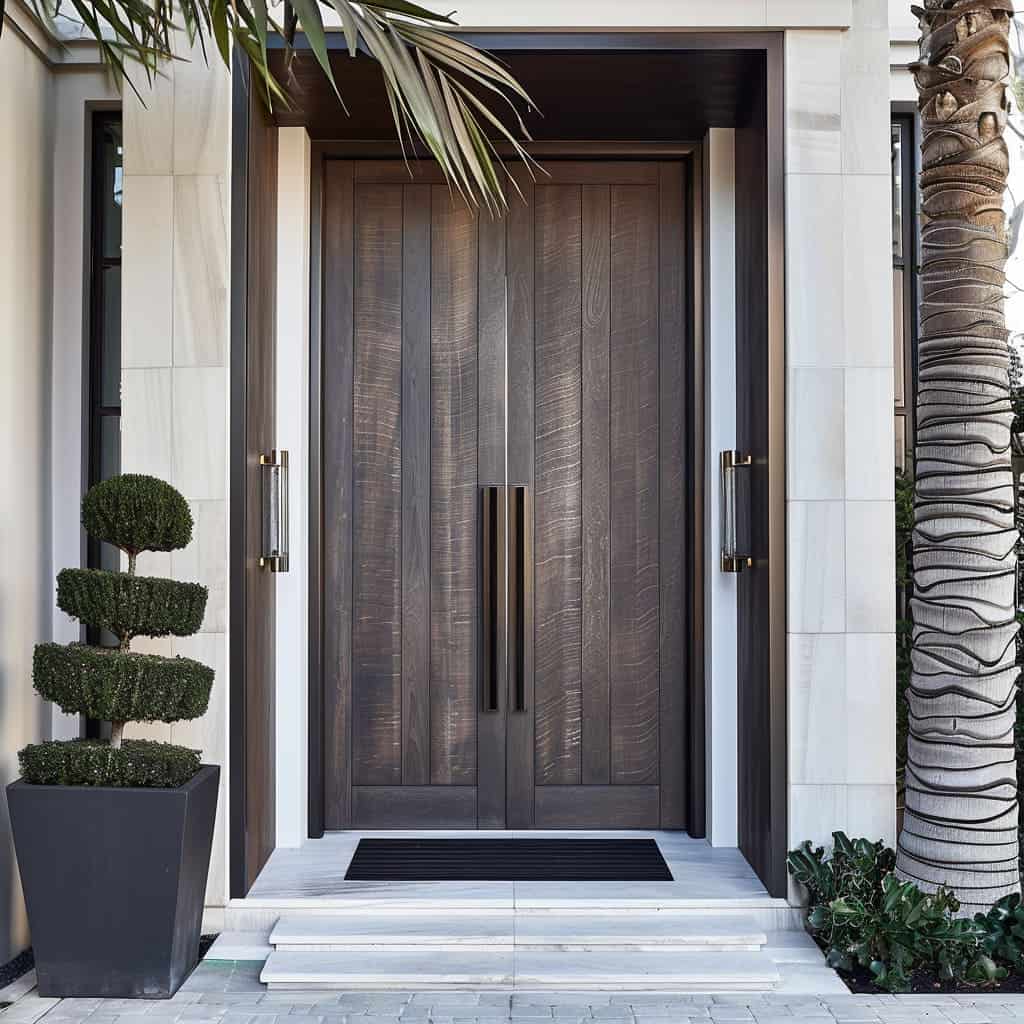
Fiberglass Doors
Fiberglass doors are a popular alternative to wood because they offer the look of wood without the high maintenance. These doors are made from durable fiberglass reinforced with a foam core for insulation. Fiberglass doors are available in various finishes, including wood-grain textures that mimic real wood.
Advantages of fiberglass doors:
- Durability: Fiberglass doors are resistant to warping, cracking, and rot, making them ideal for regions with extreme weather conditions.
- Low Maintenance: Unlike wood, fiberglass doors don’t require frequent painting or sealing. They are also resistant to rust, dents, and scratches.
- Energy Efficiency: The foam core inside fiberglass doors provides excellent insulation, which helps reduce heating and cooling costs.
Drawbacks of fiberglass doors:
- Price: While fiberglass doors are less expensive than wood, they can still be pricier than steel doors, especially when opting for premium finishes.
- Limited Customization: While fiberglass doors can mimic wood, they may lack the unique character and charm of real wood doors.
Steel Doors
Steel doors are renowned for their strength and security. They are typically made from heavy-gauge steel and filled with foam insulation for energy efficiency. Steel doors are ideal for homeowners looking for a secure, low-maintenance option.
Advantages of steel doors:
- Security: Steel doors provide excellent resistance to forced entry, making them a top choice for security-conscious homeowners.
- Energy Efficiency: The foam core of steel doors provides effective insulation, reducing energy loss and improving the home’s energy efficiency.
- Affordability: Steel doors tend to be more affordable than wood or fiberglass doors, making them a budget-friendly option without compromising on security.
Drawbacks of steel doors:
Rusting: Steel doors are coated to prevent rusting, but if the finish is scratched or damaged, the steel underneath may rust over time.
Susceptibility to Dents: Steel doors can dent if struck forcefully, and while minor dents can be repaired, the damage may still be visible.
4. Measure the Size and Fit
An improperly fitted door can lead to drafts, security vulnerabilities, and functional issues. That’s why it’s essential to measure accurately before purchasing an exterior door. Here’s how to do it:
Measuring the Width, Height, and Thickness
- Width: Measure the width from the inside of one door jamb to the inside of the other. Take measurements at the top, middle, and bottom of the door frame to account for any irregularities.
- Height: Measure the height from the floor or threshold to the top of the door frame. Again, measure on both sides and the center to ensure accuracy.
- Thickness: Most exterior doors are either 1 3/8 inches or 1 3/4 inches thick. Ensure that you measure the existing door’s thickness to match the new door.
Understanding Door Swing Direction
Exterior doors come in left-hand swing or right-hand swing options. Determining the correct swing direction is essential to ensure that the door opens in a way that suits your space. Stand with your back to the door hinge. If the door swings to your right, it’s a right-hand door; if it swings to your left, it’s a left-hand door.
Also, consider whether you want an inward-swinging or outward-swinging door based on the layout of your entryway and external space. Inward-swinging doors are more common, but outward-swinging doors can offer additional interior space and be more resistant to strong winds.
5. Prioritizing Security
Your front door is the first line of defense against potential intruders, so prioritizing security is essential when choosing an exterior door. Here are a few security features to consider:
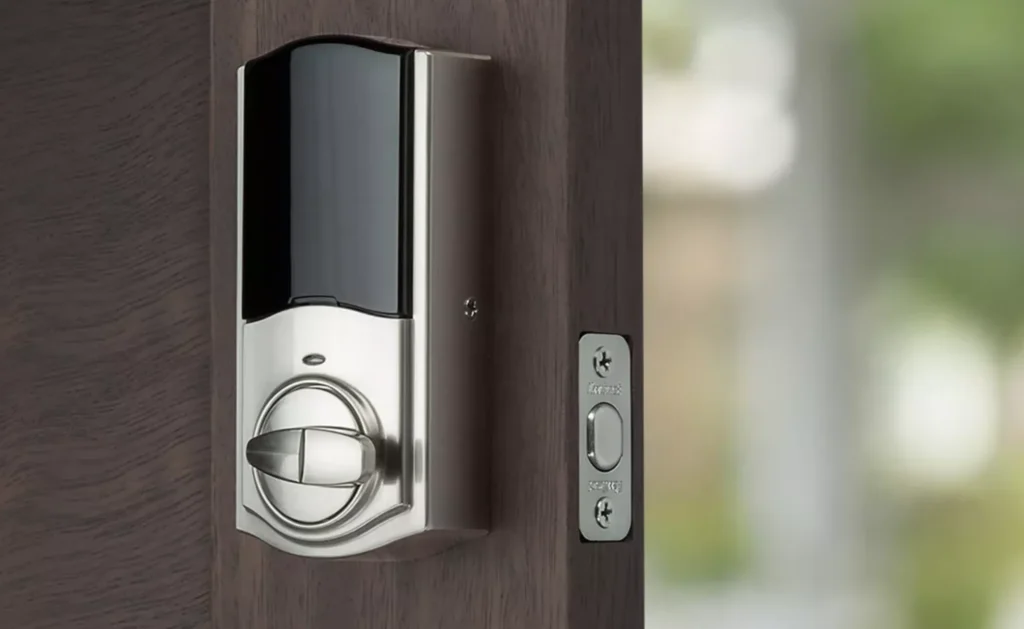
Solid Construction: Choose a door with solid construction, whether it’s wood, fiberglass, or steel. Hollow doors or those with flimsy materials are easier to break through. For maximum security, solid wood, steel, or fiberglass-reinforced doors are your best options.
- Reinforced Frame: The strength of your door depends not only on the door itself but also on the door frame. A weak or old door frame can be easily compromised, even if you have a strong door. Reinforce the frame with a steel or composite material to ensure it can withstand forceful entry attempts. Strike plates and reinforced door jambs add further resistance against forced entry.
- Deadbolt Locks: A deadbolt lock is one of the most effective security measures for your door. Unlike spring bolt locks, deadbolts can only be moved by rotating the lock cylinder, making them more difficult for intruders to pick or force open. Opt for a single-cylinder deadbolt for convenience or a double-cylinder deadbolt for added security in high-risk areas.
- Smart Locks: If you’re interested in more modern security features, consider installing a smart lock. These locks allow you to control your door’s lock mechanism remotely via a smartphone app, monitor entry logs, and even set temporary codes for guests. Many smart locks also integrate with home security systems, adding an extra layer of protection.
- Impact-Resistant Glass: If your door features glass panes, it’s essential to choose impact-resistant glass or laminated glass to prevent easy break-ins. Some doors also feature grilles over the glass for additional security. These security features prevent potential intruders from simply smashing through the glass to unlock the door from the inside.
- Peepholes and Security Cameras: For added peace of mind, install a peephole or a smart video doorbell. Peepholes allow you to see who is at your door without opening it, and video doorbells can record video footage and send real-time alerts to your phone when someone approaches your entryway.
6. Maximizing Energy Efficiency
In addition to security, energy efficiency should be a top priority when choosing an exterior door. Doors that are properly insulated and sealed can prevent drafts, reduce energy consumption, and help maintain a comfortable indoor temperature. Here’s how to ensure your exterior door is as energy-efficient as possible:
Insulation Materials and Core
Most energy-efficient doors contain a core made of insulating foam, such as polyurethane or polystyrene, which provides superior thermal resistance. Steel and fiberglass doors often come with these foam cores, making them excellent choices for reducing energy loss.
Wooden doors can also offer good insulation, but they tend to be less energy-efficient than fiberglass or steel unless they are paired with energy-efficient features like high-performance weatherstripping.
ENERGY STAR Certification
When shopping for exterior doors, look for the ENERGY STAR certification. This label indicates that the door has met stringent energy performance standards set by the Environmental Protection Agency (EPA). ENERGY STAR-certified doors are designed to minimize heat transfer and reduce energy consumption, helping to lower your utility bills.
Weatherstripping and Door Seals
Proper weatherstripping around the perimeter of the door is essential for energy efficiency. Weatherstripping creates a tight seal between the door and the frame, preventing air leaks and drafts. Over time, weatherstripping can wear out, so it’s important to inspect it regularly and replace it when necessary.
In addition to weatherstripping, ensure that your door has a door sweep at the bottom to block drafts from entering underneath the door. Many modern doors also feature magnetic or compression seals, which create an even tighter seal when the door is closed.
Low-E Glass for Glass Inserts
If your door has glass panes, consider using Low-E (low-emissivity) glass. This type of glass has a special coating that helps reflect heat back into your home in the winter and keeps it out in the summer. Low-E glass is a great option for maintaining energy efficiency without sacrificing the natural light that glass doors provide.
Avoiding Heat Transfer with Proper Door Installation
No matter how energy-efficient your door is, poor installation can lead to significant energy loss. It’s crucial to have your door professionally installed to ensure a proper fit and tight seal. Gaps between the door and the frame or misaligned hinges can result in drafts, reducing the door’s energy efficiency. Always check that the door opens and closes smoothly and that there are no visible gaps around the edges.
7. Custom Door Options
Your exterior door should reflect your personal style and complement your home’s design. Here are a few ways you can customize your door to make it unique:
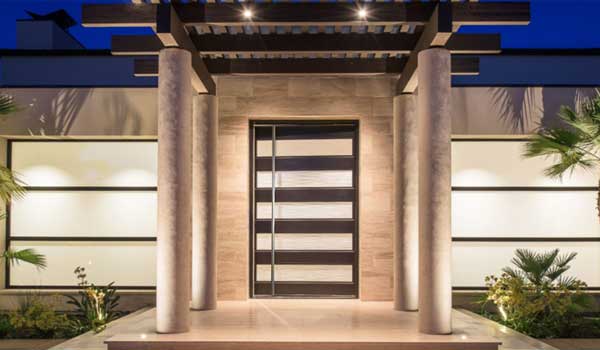
Door Colors and Finishes
One of the simplest ways to personalize your door is by choosing the right color. Bold, vibrant colors like red, navy blue, or yellow can make a statement and draw attention to your entryway, while neutral tones like black, gray, or white provide a timeless and sophisticated look.
If you opt for a wood door, you can choose from a variety of stains that enhance the wood’s natural grain and color. Fiberglass doors can also be painted or stained to match your desired look.
Glass Options
Glass inserts in doors can add beauty and light to your entryway. You can choose from clear glass for maximum visibility and brightness, frosted glass for privacy, or decorative glass for an artistic touch. Glass options can also be customized with different shapes, sizes, and patterns.
Some homeowners prefer a full glass door, while others choose a solid door with smaller windows or sidelights on either side. Transom windows above the door are another way to bring in additional light while maintaining privacy and security.
Hardware and Accessories
The hardware you choose for your exterior door can make a big difference in its overall appearance and functionality. Choose from a variety of handles, knobs, and levers in different finishes such as brass, chrome, nickel, or matte black.
Other accessories to consider include:
- Door knockers: Traditional or modern knockers can add a personal touch to your entry.
- Kickplates: Metal kickplates at the bottom of the door protect it from scuffs and add a decorative element.
- House numbers: Stylish house numbers above or beside your door create a cohesive look.
- Mail slots: If your door is used as the main entry for mail delivery, a built-in mail slot is a functional feature that can be styled to match your door hardware.
Storm Doors and Screen Doors
In some climates, adding a storm door or screen door in front of your main door can provide additional protection from the elements. Storm doors are typically made from glass and provide an extra layer of insulation, while screen doors allow for airflow and ventilation during warmer months without letting in bugs.
Storm doors can also improve security by adding another barrier against forced entry. They come in various styles, so you can find one that complements your exterior door’s design.
Maintenance Tips for Exterior Doors
Once you’ve chosen the perfect exterior door, it’s important to maintain it properly to extend its lifespan and keep it looking great. Here are some maintenance tips based on door materials:
- Wood Doors: Regularly inspect wood doors for signs of moisture damage, warping, or cracking. Reapply varnish or paint every few years to protect the wood from the elements.
- Fiberglass Doors: Fiberglass doors require minimal maintenance. Clean them periodically with mild soap and water, and check the finish for any signs of wear. If the door is painted or stained, you may need to refresh the finish every few years.
- Steel Doors: Inspect steel doors for scratches or dents that could lead to rusting. Touch up scratches with paint or a rust-inhibiting primer to prevent corrosion. Clean the door regularly with a mild detergent to remove dirt and grime.
In addition to maintaining the door itself, remember to check and replace weatherstripping as needed to maintain energy efficiency. Keep the hinges and locks lubricated for smooth operation and inspect the door frame for any signs of wear or damage.
Conclusion: Making the Right Choice
Choosing the right exterior door is about balancing style, security, energy efficiency, and durability. By considering the material, design, and additional features, you can select a door that enhances your home’s curb appeal while providing long-term protection and savings.
Whether you’re looking for a statement piece that reflects your unique style or a practical, energy-efficient door to reduce utility costs, there are countless options available to fit your needs. Take the time to evaluate the best material for your climate, measure for a perfect fit, and prioritize security and energy-saving features.
Ultimately, your exterior door is an investment in your home’s value, safety, and aesthetic appeal, so choose one that meets your functional needs and complements your personal taste. With the right door, you can create a beautiful and secure entrance that welcomes you home for years to come.
